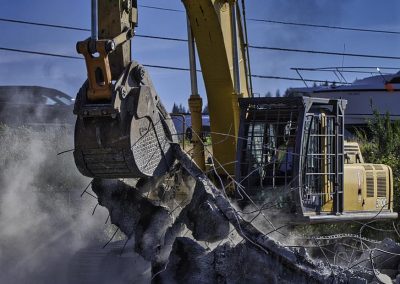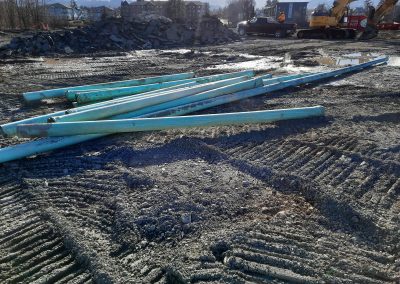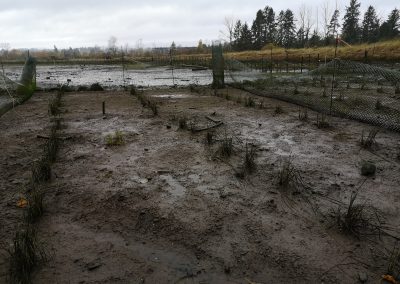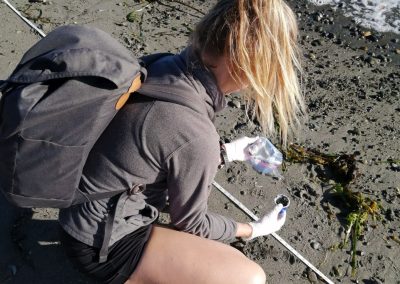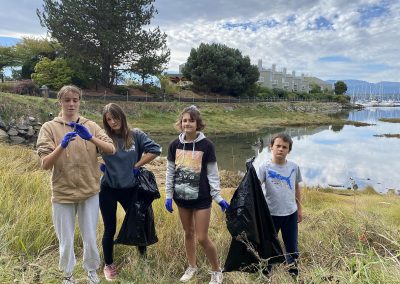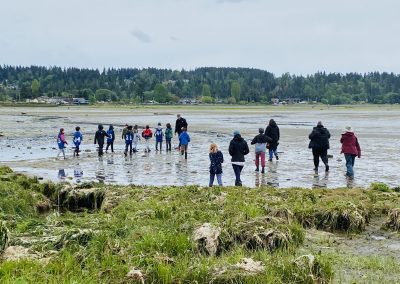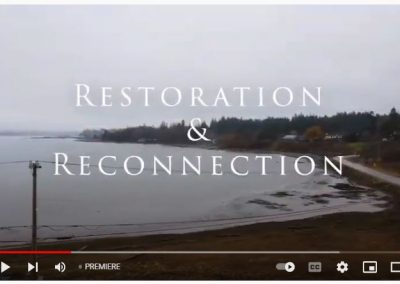Project Watershed’s 2022 Annual General Report
Photo Gallery
Words from our Executive Director, Caitlin Pierzchalski
Thank you to all our members, board, staff, and community supporters for making 2021-2022 Project Watershed’s biggest year yet! We managed and coordinated 5 different restoration projects, our Keeping It Living Dinner, brought in $1.8 million dollars in grants, and started restoration on our largest project to date, Kus-kus-sum. It’s been quite the year and we couldn’t have done it without you, our community. Thank you!
Human Resources
Project Watershed welcomed some great new full-time and part-time staff in 2022, including a new Office and Finance Specialist and four part-time Environmental Technicians. Terria Hanuse, our new Office and Finance Specialist, joined the team back in February and brings 18 years of experience in finance and bookkeeping to the position.
During our busy summer months last year, we were able to hire four environmental technicians, Jeremiah Bain, Zoe Cilliers, Samantha Huong, and Jamie Lund through the Healthy Watersheds Initiative funding. They worked together as a super team to help support our restoration and monitoring efforts at Kus-kus-sum and Hollyhock flats, as well as our Glen Urquhart restoration project, forage fish sampling, and coastal restoration projects. We are currently in the process of hiring summer staff again this year through Canada Summer Jobs. By the end of the month, we will have two environmental technicians and a communications specialist on board.
We said goodbye to some longtime friends and colleagues this past year, Fran Kweicien and Kathryn Clouston, and wish them many exciting and happy returns on their adventures into their part-time and full-time retirements. We are also still feeling the loss of Board Member, Bill Heidrick. Thank you to everyone who has donated to Project Watershed in his name raising over $14,200 for restoration.
Kathy Haigh assumed the position of Chair this year with Patricia Sloan supporting her as Vice Chair. The rest of our directors remain with us in their roles: Alisha Drinkwater, Co-Vice Chair; Brian Storey, Treasurer; Dan Bowen, Technical Director; Don Castleden, Estuary Working Group Chair; Bill Heath, Mapping and Kelp Director. For more information about each of them, visit our Board Directory.
Our permanent staff team continues to include Caitlin Pierzchalski, Executive Director; Jennifer Sutherst, Senior Staff Biologist; Caila Holbrook, Manager of Outreach and Education; Virginia East, Citizen Science & Stewardship Coordinator and Jay Baker-French, Restoration Specialist. For more information about our staff please visit the Staff Directory.
We have had another great year of volunteer support with over 155 volunteers giving over 1200 hours of their time to support our projects, events and other initiatives. It has been awesome to be able to work together towards Keeping It Living in the Comox Valley and we look forawd to the activites that 2022-2023 will bring.
Please note we are working to phase office hours back into our routine this year and will post these hours on our website in our calendar once they have been confirmed.
This last year was a full one at the Kus-kus-sum site. Copcan Civil Ltd was the successful bidder for our tender to do the concrete and asphalt removal. With their help we were able to unpave the area (all except for a small portion near the south gate that has been left for parking/staging). Due to the sheer amount of concrete and asphalt that was on the site we did this in stages. The first and most intensive stage was the removal of the surface concrete which occurred over the summer of 2021. The concrete was laden with rebar which was removed, trucked off site and recycled. The concrete was crushed and removed from the site by developers, businesses, and individuals to be used in local projects.
During this stage most of the asphalt was also removed. Subsurface concrete removal was initiated in October but could not be completed. Work was halted and the site was prepared for overwintering. The remainder of the subsurface concrete, including the concrete wall that was found inside the steel wall that lines the site, was removed in February and March of 2022.
In April 2022, we re-contoured and planted a small section of the site next to the 17th St Bridge. This pilot has been super successful. Over 400 plants were planted and mulch and compost spread by just over 30 volunteers in a period of 2 days. Baseline monitoring data was also collected from Hollyhock Flats Conservation Area, our reference site, with a focus on vegetation and fish and wildlife monitoring.
Funding for the restoration of Kus-kus-sum is currently coming from a variety of contributors including:
- British Columbia Salmon Restoration and Innovation Fund
- the Healthy Watersheds Initiative, which is delivered by the Real Estate Foundation of BC and Watersheds BC, with financial support from the Province of British Columbia as part of its $10-billion COVID-19 response.
- the Fish and Wildlife Compensation Program
- the World Wildlife Fund
- the Habitat Conservation Trust Fund
- the Pacific Salmon Foundation
- and the general public
Project Watershed thanks everyone involved in the fundraising process, the most current list of donors is available at Friends of Kus-kus-sum.
Kus-kus-sum Page
Friends of Kus-kus-sum
Donate
Sponsor a Business Salmon
Latest Kus-kus-sum News
Shifting Focus at Kus-kus-sum
The Kus-kus-sum project is not without its challenges. The biggest challenge at present is soil quality.
Kus-kus-sum Progression
The Kus-kus-sum project has been flourishing with significant strides in recent times, evoking a sense of hope and admiration among all those involved. The vision of revitalizing the once degraded site into a thriving habitat is now becoming a tangible reality.
Earthworks Continue at Kus-kus-sum
While the Kus-kus-sum site is already beginning to come into its own, there is still much work to be done. Just over one third of the area was recontoured and planted last year in 2022. Project Watershed aims to recontour and replant the remainder of the site this summer and fall, if funding allows. The key works you will see on site this year include recontouring and regrading, habitat complexing, and native species planting.
Kus-kus-sum Restoration Overview
The restoration will occur in 3 phases. Click below to read more about each phase and scroll down to see a visual representation of the site features found on the restored Kus-kus-sum site. During Phase...
Kus-kus-sum Site History
A short history of the Kus-kus-sum site from pre-European contact to the present day.
We had a very successful year wrapping up our Coastal Restoration Fund projects. The Coastal Restoration funding we recieved was for a five-year period that ran from 2018-2022. This funded many projects that focused on salt and tidal marsh restoration, eelgrass restoration, and kelp restoration, as well as extensive coastal monitoring and planning.
- Jennifer Sutherst has updated our coastal restoration plan for 2022, and it is available on our website.
- In collaboration with Angela Spooner, we transplanted a 1000m2 at Miracle Beach this year that was deferred from the year previous
- Most of this year’s coastal restoration fund work focused on signage, monitoring, and reporting as we wrap up all the many restoration projects that occurred over the last 5 years under that funding
Over the past year, we have also done work in the area of Green Shores. In collaboration with Pacific Salmon Foundation, the BC Stewardship Centre and the CVRD, we have undertaken a feasibility and scoping study for the CVRD-owned Rotary Viewing Stand Park on Comox Rd. The aim of the work was to highlight opportunities and costs for applying a green shores restoration perspective to that park. Work is currently in the planning stages and restoration works will likely be taking place in 2023/2024.
Glen Urquhart
In August of 2021, we used a small excavator to remove rhizomes of reed canary grass (RCG) from a heavily infested ephemeral wetland area that is hydrologically connected to Glen Uruqhart Creek and provides amphibian habitat. RCG Rhizomes were buried on-site, and the edges of the wetland were replanted with a diverse mix of low-growing riparian species. In an exciting turn of events, we found a rare plant, Vancouver Island beggarticks, growing in the ephemeral wetland. Restoration works will likely increase the habitat area for this species and we will be monitoring for this during 2022. In the fall of 2021, we completed extensive riparian plantings along the creek and a newly restored ephemeral wetland area.
Currently, in-stream works are moving forward for this project. The required permits has been submitted with support from Fisheries and Oceans Canada. The plan is to install three riffles that will improve summer rearing habitat for juvenile Coho and cutthroat trout. In addition, we will stabilize the stream banks using live willow stakes this fall.
We are also developing designs for future in-stream restoration with a focus on increasing off-channel habitat. This work is being carried out in collaboration with Ducks Unlimited Canada (DUC) as we are implementing part of a three-year climate nature-based solutions grant they have for work on their property. We are also planning future works in collaboration with DUC which include piloting Garry Oak ecosystem restoration, more wetland restoration, and more stream habitat work.
Mallard Creek
In the fall of 2021, we live-staked a section of the creek that had been cleared of RCG in 2019. Willows are doing well in most places, though the heat wave and deer browsing damaged the willows in one area. In 2022, we will be clearing out reed canary grass (RCG) from another section of the creek channel on DUC property (Simpson Farm) using a small excavator. RCG will be suppressed using willow live staking as we have done on other reaches of the creek with satisfactory results. Then in the fall, we will plant some upland riparian species to increase diversity of the riparian corridor.
Project Watershed has been engaged in forage fish research, focused of Pacific sand lance and surf smelt, for over three years. Forage fish are small schooling fish that play a critical role in in the marine ecosystem. Our team has included Georgie Harrison of North Island University, the K’òmoks First Nation (KFN) Guardians and a wide variety of citizen science volunteers. The 2021-2022 period was the last year of our BC Salmon Restoration and Enhancement Fund grant, however, Project Watershed has chosen to continue this project. We are actively seeking funding sources to continue this work both locally and expanding into unsurveyed areas.
Highlights:
- Eggs were found at: Tree Island with support from the KFN Guardians and again at Kye Bay, Goose Spit, and Air Force Beach
- Curtis Beach – Blitz site and Forage Fish Habitat Assessment site and an egg was found at this site
- Over 3 years we established 8 Core Beaches – some beaches have multiple sites sampled at the sample beach (ie Masons Landing and Goose Spit). These are sites we return to regularly
- Cortes Island (Mansons Landing – 2 sites and Smelt Bay – 1 site)
- Quadra Island (Rebecca Spit – 1 site)
- Campbell River (Frank James Park – 1 site and Oyster Bay Shoreline Park – 1 Site)
- Comox Valley (Air Force Beach – 1 site, and Goose Spit – 3 sites)
- Hornby Island (Shingle Spit – 1 Site)
- We have established 35 Blitz Sites which are monitored approximately once a year
Partnerships:
- We have benefited from leadership from Environment and Climate Change Canada (ECCC), Province of British Columbia, University of Victoria Geography and Microbiology Departments, Fisheries and Oceans Canada (DFO) – Cliff Robinson and Beatrice Proudfoot, Jacklyn Barrs from WWF-Canada, and the others monitoring forage fish throughout the Salish Sea.
- Academic Researchers – Jacqueline Huard (MSc – UBC Forestry – Intertidal Model and Treats Document), Nicola Houtman (UVic – Geography Department), and Will Duguid (UVic – Post Doctorial Fellow – Adult Salmon Diet Programme and the Winter Juvenile Chinook Salmon Diet Programme)
- Co-op Student (university of Victoria – Department of Geography Nhan (Young) Nguyen) Fall 2019 – Development FF monitoring plan and intertidal model for northern Salish Sea
- Other contributors include the in-kind leadership of volunteers, students and staff of North Island College in both the Comox Valley and Campbell River, Friends of Cortes Island (FOCI), Conservancy Hornby Island (CHI), and Quadra Island (Team Quadra).
- Tiara Jacobson – Ocean Wise – Direct Action – Ocean Bridge Ambassador – Winter 2021-2022 Field and environmental DNA (eDNA) processing – Amazing Support and Leadership
Project Watershed would like to thank out financial contributors. Without their financial contributions we would not have been able to establish a robust forage fish programme within the northern Salish Sea between 2019 to 2022.
- British Columbia Salmon Restoration and Innovation Fund
- the Pacific Salmon Foundation
- and Comox Valley Regional District
Donate
Latest Forage Fish News
Forage Fish Sampling – Spring/Summer 2024
Forage fish sampling is starting back up again in May!
Forage Fish Symposium
The forage fish team has been busy planning the Coastal Forage Fish Network Symposium. Hosted on Zoom, this event brings together researchers, experts and community citizen science volunteers to share research highlights from across Vancouver Island and beyond.
Project Watershed receives $1.4 million to support forage fish research!
Project Watershed is very excited to announce the award of $1.4 million dollars of funding from the BC Salmon Restoration and Innovation Fund to support our forage fish research, monitoring and restoration!
Education Initiatives
Project Watershed eased back into doing in-class presentations and in-person field trips this year. Our Students Keeping It Living Program was very popular; we have teachers who have already signed up for next year. Our program consists of an in-class presentation, a field trip and a follow up art/literature project. This school year we provided the program to approximate 250 students. As a part of this program some of these students have painted salmon for the Kus-kus-sum fence.
Over the past year we have collaborated with post secondary students and institutions in our research and restoration projects. This collaboration helps us stay on top of cutting-edge research and development in our area, strengthens our partnerships and increases our knowledge base. Examples of these mutually beneficial relationships can be found through out the other sections of this report.
We are hoping to expand our education initiatives and are waiting to hear back from granting agencies regarding funding this aspect of our work.
Resources K - 12
We have been pleased to have more and more opportunities to interact with our community in person and have also been grateful for our continued online interactions as well. Once again this year, we provided presentations on watersheds, estuaries and specific projects through a variety of forums, workshops, conferences, Zoom meetings and in-person meetings. We also and a variety of events that helped raise funds and steward our beautiful Comox Valley.
Our largest fundraiser for this year was the Paintings, By The Numbers Event which took place on May 14th and raised over $26,000. Giving Tuesday was another successful event that raised over $10,000. We also developed and launched a new line of E-cards available through CanadaHelps. We saw some success with them over the winter period and are hoping they gain more tracktion this year.
For Earth Day we planted a variety of native species with volunteers at the Airpark and attended Mark Isfeld’s Ecofair and the Comox Earth Day celebrations. We are very proud of the latest Youth Media Project collaboration with Maddelin Thomas entitled Restoration and Reconnection and are grateful for the volunteers and the group of grade seven students from Cumberland Elementary who have created wooden salmon cut outs for the Sponsor A Salmon fundraiser.
Latest Community Outreach News
Earth Week with Project Watershed
Spring has sprung and we are busy planning for Earth Week 2021! Earth Week is April 16 – 22, and we will be celebrating our love for this planet with a host of activities to support the health of our Lands and Waters.
Paintings, By The Numbers Gallery
Ken Kirkby and Nana Cook have donated 43 of their paintings and seven from their collection to raise funds and awareness for Kus-kus-sum through the engaging and powerful medium of art and the promise of getting a great deal. Each painting is worth between $1,500 and $4,000.
Paintings, By the Numbers
Ken Kirkby and Nana Cook have donated 43 of their paintings and seven from their collection for a semi-formal gala event to raise funds and awareness for the purchase and restoration of Kus-kus-sum through the engaging and powerful medium of art and the promise of getting a great deal. Each painting is worth between $1,500 and $4,000. 50 ART DRAW tickets at $500 each will be presold for the event (ART DRAW ticket holders may bring 1 guest). Tickets to attend the event as an onlooker will be $15.








